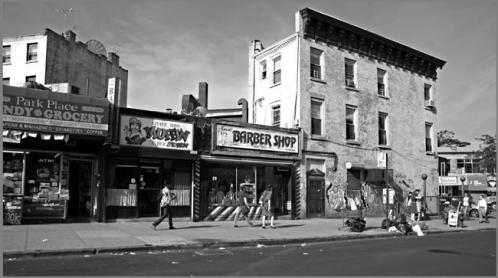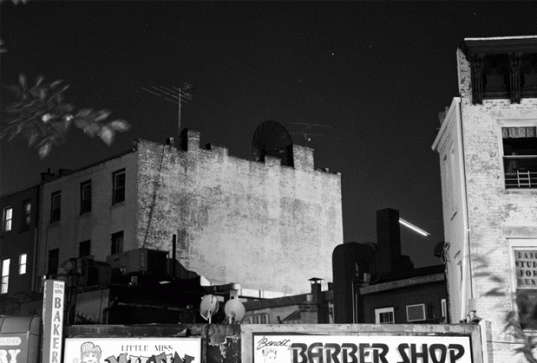My block in Brooklyn plays a good Hudson Street — at least at first glance. Each morning, the cigar-store owner throws open his gate, the barber puts out his chairs, the baker begins her muffins, and the old man a few doors down takes up his surveillance from the second-floor window. When I make my own first entrance a little after seven, with the dog, the newspaperman calls me “boss.” It may all look like Jane Jacobs’s glorious sidewalk ballet, but this is no longer Jane Jacobs’s city.
When I “look, listen, linger and think” about my corner of the world, I am persistently confronted with the broader world beyond. The barbershop chatter is in Creole, the cigar store might be closed for the end of Ramadan, and the cyclical chanting of capoeira, the Brazilian martial art, echoes from an upstairs dance studio. Planes pass overhead on their way to La Guardia. And at all hours people pause at the top of the subway stairs to finish their cell-phone conversations.

This last activity is remarkably dominant and has come to define the character of the place. They lean against the station railing three or four at a time, talking with one hand to an ear and their heads cocked high. Like a lot of things here, they are deeply connected to other places. Their attention is divided. And, by extension, so is ours. While this feeling is common to all cities over time, cell phones bring the tangible immediacy of the faraway to the street. Helped along by media and the global logistics networks that define our material lives, our moment-to-moment experience of the local has become increasingly global. And so have our problems.
Jacobs fought modernist urban planning’s “dishonest mask of pretended order,” and what concerns me today about cities is a corollary: call it the dishonest mask of pretended localism. Thanks in great part to Jacobs, we talk a lot about preserving neighborhoods, which most often means keeping them the way they are. But for me, preserving an urban community — not merely its architecture, its open space, or its independently owned stores — now means recognizing what the local is made of, the warp and weft of all its pieces, wherever they come from, near or far. And that requires recognizing the global community behind it — for better or worse, in the face of both nostalgia and change.
There is a practical need for this double sense of “preservation”: the efficiency of cities is a crucial antidote to global warming and resource management. Yet despite the enormity of these stakes, both social and environmental, traditional environmentalism in America has long resisted an urban identity. Most of the loudest “environmental” voices and most prominent organizations remain focused “out there,” in the countryside and the wilderness — or in their more easily habitable stand-ins, the suburbs and exurbs. But as the historian William Cronon points out, “idealizing a distant wilderness, too often means not idealizing the environment in which we actually live.”
Yet a new generation of environmentalists, banded together in organizations such as Worldchanging, has begun to shift its attention to cities and align the concept of “green” with technology and urbanization rather than simplicity and nature. Logically, that shift should be easy. Aesthetically, it’s a lot harder. Thinking of cities this way means seeing their density and grit not as the destruction of the environment but as part of its preservation. The Jacobsean conundrum (and the unspoken subtext of every NIMBY argument) is that the environmental preservation of the future may require the destruction of pieces of the past. But if we can recognize the beauty in its benefit, it won't be a bitter pill.
I saw this firsthand while living in Toronto, just a few blocks from Jacobs’s home on Albany Avenue. It is a wonderful urban neighborhood, treed, friendly, and alive. But Toronto was sick at the edges. Thanks to a strong sense of identity — much of it built on Jacobs’s own vision and activism — Toronto’s relatively low-density downtown neighborhoods have been (until recently) well protected from new tall buildings. As an active participant in Toronto civic politics, Jacobs often showed up at planning meetings to fight the destruction of a beautiful old block in favor of some new condominium tower. The neighborhood was all.
But I couldn’t help but see what was happening in the broader city: growth was being shunted to the suburbs, the number of “smog advisories” increased each summer, and the subways were often empty. In truth — overrun by cars, eyes tearing from the bad air — I began to sour on Jacobs, not as an observer of the city or an impassioned describer of its life but on account of what struck me as the shortsightedness of her localism, or at least the localism shouted in her name.
“I think we’re not too far off from recognizing that it’s a moral imperative to add density to any place with a transit stop,” believes Christopher Leinberger, author of The Option of Urbanism — displaying plenty of the modernist brio and contempt for the souls of cities that Jacobs fought. But I’m tending to agree. We are wedging ourselves between a rock and a hard place: between the pleasures of medium-density living (Greenwich Village, Park Slope, Toronto’s Annex) and the ecological necessity of even more density. When it comes to our homes, we are all justifiably afraid of change, especially when it feels like (or is) destruction. But we don’t often pair that truth with another oft-repeated one: our way of life is unsustainable. In North America’s most beautiful urban places, we unfailingly fight every new tall building in the name of “quality of life” and the “character of the neighborhood.” We claim to have internalized the idea that it’s all connected, that slowing the warming of the planet is a global project, but the nature in our backyards remains sacred — often to the point, perhaps, of self-destruction.
I know I’m dancing a little too closely with the clean-sweep modernist planning Jacobs rightfully fought. But the contradictions we face are too challenging not to. I like how the urbanist Marshall Berman puts it: to be a modernist is to be “at home in the maelstrom.” "To be modern is to find ourselves in an environment that promises us adventure, power, joy, growth, transformation of ourselves and the world — and, at the same time, that threatens to destroy everything we have, everything we know, everything we are.” We can resist the extremes of modernism and all its failures; but that does not free us from facing up to the same challenges and inequities that modernism sought to rectify. I don’t know that Jane Jacobs fully accepted this.
But to the extent that we can create new solutions, looking to the hearts of neighborhoods — the people and the web of connections found there — may give us reason to be optimistic. A tenet of modernist planning was that cities didn’t matter any more, that communications technology (much less the threat of nuclear war) rendered them useless and inefficient. Of course, the opposite has proved true. As technology has lowered the barriers between places, the differences between them have become accentuated. At least at a global scale, when ideas and capital flow freely, they tend to dry up in some places and pool in others — as in New York. But the influence of communication technology is beginning to have an impact at the neighborhood scale as well. Jacobs wrote that “word does not move around where public characters and sidewalk life are lacking.” Now it does. There are the people paused at the top of the subway stairs, occupying two spaces at once, one physical, one virtual. And in neighborhoods around the country — this one in particular — community online message boards and blogs are thriving, entirely in parallel with news passed stoop to stoop.
The “in parallel” part is crucial. Outside .In, a website designed to gather and organize neighborhood news, published a list of “America’s Top 10 Bloggiest Neighborhoods.” What was striking (but perhaps not surprising) is that all were living examples of the kind of places Jacobs championed: Clinton Hill in Brooklyn, Potrero Hill in San Francisco, Shaw in Washington. If the physical form of a neighborhood is conducive to community, so is its virtual form. But the other striking thing about the list was that all the neighborhoods were in a state of change — gentrifying or recently gentrified. It’s certainly demographic: a neat and obvious alignment of hipster and blogger. But it also means that the newly emerging character of these places is being forged, at least in part, online. These are incontrovertibly real-world neighborhoods, but their community is as virtual as it is physical. With each year, we get better at navigating between the two.
Facebook and MySpace have begun to show how textured online group interactions can be. It’s easy to think of social networking in terms of Hudson Street, and easy to think of Hudson Street in terms of social networking. Both are at their best when they can successfully balance the public and the private. In his book Emergence: The Connected Lives of Ants, Brains, Cities, and Software, Steven Johnson — who, not coincidentally, created Outside.In — shows the similarities between the ad hoc, bottom-up life of the Web and that of urban neighborhoods. Yet so far, the two aren’t fully feeding off of each other. Those bloggy neighborhoods excepted, we’re not fully connected, neighbor to neighbor. But we’re connected enough, I think, that the payoff is becoming visible: in a community where common ties are electronically buttressed, we may be able to reap the global environmental benefit of high-density living without sacrificing the local ties of a medium-density neighborhood. Jacobs’s legacy may be crashing up against a conflict of scales, but this could soften the blow.

I recently heard a rumor, passed stoop to stoop, that the owner of the wonderful urban agglomeration across the street — newsstand, bakery, barbershop, capoeira studio — is putting the whole thing up for sale. Fronting partly on Flatbush Avenue, its zoning would allow an apartment tower. I can easily see the good: here’s the proverbial tower over a transit stop. There’s no historic value to the architecture of the existing buildings, and the new could even be beautiful, maybe using the latest low-energy technology and designed in a style as representative of this age as the brownstones were of a century ago. But I’d be lying if I weren’t horrified by the loss of the stores or, more important, the “public characters” who run them. Their spirit — indelibly tied to this place, as no Starbucks ever could be — has accrued over decades and would not be simple to replace. It’s easy to say that the city must evolve, but that doesn’t mean I wasn’t shocked by its speed. Still, you won’t find me on the barricades fighting against it. There’s more at stake than being called “boss.”